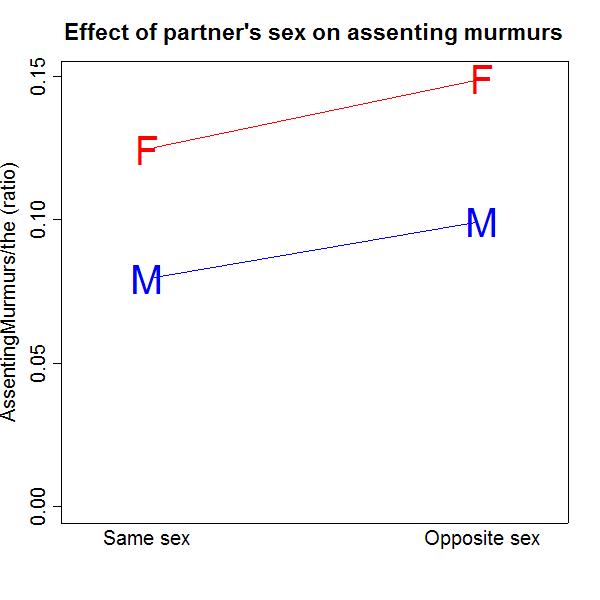November 08, 2005
Another breakfast experiment
This time the subject is sex and murmurs of assent. Read on for the details, which are less interesting than you think. Or maybe more interesting, depending on your outlook and ... Never mind, you'll see what I mean.
Thanks to a nice database access program written by Mike Schultz (now at Microsoft Research), with a web interface written by Bill Clark and Shawn Medero, I can submit a query like
"uh-huh" & sex:female & sex_opp:male
and 57 milliseconds later, learn that my query "returned 11749 hits in 2719 documents" from a large collection of transcribed telephone conversations. The meaning of the query is "tell me about the search string 'uh-huh', looking only at female speakers who are talking to male conversational partners". I can also read the transcripts of the hits, and listen to the associated audio, but that takes too much time for current purposes -- this morning, I've only got a half an hour over a couple of cups of breakfast coffee.
In an earlier post, I looked at the frequency of uh, um, uh-huh, mm-hmm etc. as a function of speaker sex and age. This morning, I thought I'd check the effect of the sex of conversational partners.
For the first mini-experiment, I checked the counts of uh-huh and um-hum (which is how these transcripts mostly represent the sound more commonly transcribed as "mm-hmm"). Summing the various ways of transcribing assenting murmurs, and normalizing by the counts for the word the for the same speakers in each category, the results look like this:

Male speakers produced assenting murmurs 25% more often when talking with a woman than when talking with another man. Female speakers murmured assent 20% more often in cross-sex than in same-sex conversations. (The question of statistical significance will have to wait for another time -- but the Ns are pretty big here.)
Andrew Gelman over at Statistical Modeling, Causal Inference and Social Science (and by the way, I think that's the longest name among the blogs that I read regularly) suggested some improvements in my earlier um/uh/mmm-hmm plots. So in the plot above, I've started the y-axis at 0, and made the males blue and the females red. And here are some plots of the effects on "uh", "um", "yes" and "no", arranged in Andrew's recommended par(mfrow=c(2,2)) format (that's R-ese, for those of you who are not in the R subculture).

The counts for uh and um have had the counts for uh-huh and um-hum subtracted from them, as in my earlier post.
Note that these conversations involve strangers having telephone conversations on an assigned topic, and the results may not necessarily generalize to other sorts of interactions. In fact, that lesson is implicit in the results themselves, and in my opinion is the most important result of this sort of exercise.
The counts that we get from analyzing people's behavior can be significantly affected by many properties of the people and their context, and also by many interactions among these properties. We need to be careful about jumping to conclusions, especially when dealing with variables like sex that have a wide range of associated stereotypes with strong emotional loading.
Posted by Mark Liberman at November 8, 2005 09:03 AM